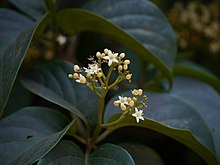| Icacinaceae Temporal range: [1]
| |
|---|---|

| |
| Nothapodytes nimmoniana | |
| Scientific classification | |
| Kingdom: | Plantae |
| Clade: | Tracheophytes |
| Clade: | Angiosperms |
| Clade: | Eudicots |
| Clade: | Asterids |
| Order: | Icacinales |
| Family: | Icacinaceae Miers[2] |
| Genera | |
|
See text | |
The Icacinaceae, also called the white pear family,[3][4] are a family of flowering plants,[5] consisting of trees, shrubs, and lianas, primarily of the tropics.
The family was traditionally circumscribed quite broadly, with around 55 genera totalling over 400 species. In 2001, though, this circumscription was found to be polyphyletic,[6] and the family was split into four families in three different orders: Icacinaceae sensu stricto (then unplaced at order rank), Pennantiaceae (Apiales), Stemonuraceae (Aquifoliales) and Cardiopteridaceae (also Aquifoliales). Other genera have later been moved to Metteniusaceae (Metteniusales),[7] so that Icacinaceae now include c. 23 genera and 160 species. One genus, Sleumeria, was described as late as 2005.[8]
Icacinaceae belongs to the order Icacinales along with Oncothecaceae.[2] The oldest member of this family is Palaeophytocrene chicoensis from the Campanian of California, known from a fossil fruit from the Chico Formation.[1]
Icacina senegalensis extracts have shown activity against malaria parasites.[9]
- ^ a b Atkinson, Brian A. (14 November 2022). "Icacinaceae fossil provides evidence for a Cretaceous origin of the lamiids". Nature Plants. 8 (12): 1374–1377. doi:10.1038/s41477-022-01275-y. ISSN 2055-0278. PMID 36376504. S2CID 253521093.
- ^ a b Angiosperm Phylogeny Group (2009). "An update of the Angiosperm Phylogeny Group classification for the orders and families of flowering plants: APG III" (PDF). Botanical Journal of the Linnean Society. 161 (2): 105–121. doi:10.1111/j.1095-8339.2009.00996.x. hdl:10654/18083. Retrieved 2013-07-06.
- ^ "Apodytes dimidiata". November 20, 2017.
- ^ "white pear family - Encyclopedia of Life". eol.org.
- ^ "Icacinaceae" At: Angiosperm Phylogeny Website At: Missouri Botanical Garden Website (see External links below).
- ^ Kårehed, Jesper (2001). "Multiple origin of the tropical forest tree family Icacinaceae". American Journal of Botany. 88 (12): 2259–2274. doi:10.2307/3558388. JSTOR 3558388. PMID 21669659.
- ^ Stull, G. W., R. Duno de Stefano, D. E. Soltis, and P. S. Soltis (2015). Resolving Basal Lamiid Phylogeny and the Circumscription of Icacinaceae with a Plastome-Scale Data Set. American Journal of Botany 102, no. 11: 1794–1813. doi:10.3732/ajb.1500298.
- ^ Timothy M.A. Utteridge, Hidetoshi Nagamasu, Stephen P. Teo, Lydia C. White, and Peter Gasson. 2005. "Sleumeria (Icacinaceae): A New Genus from Northern Borneo". Systematic Botany 30(3):635-643.
- ^ Sarr SO, Perrotey S, Fall I, Ennahar S, Zhao M, Diop YM, Candolfi E, Marchioni E.,"Icacina senegalensis (Icacinaceae), traditionally used for the treatment of malaria, inhibits in vitro Plasmodium falciparum growth without host cell toxicity." Malar J. 2011 Apr 11;10(1):85